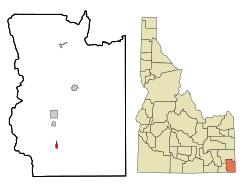St. Charles, Idaho
St. Charles, Idaho | |
|---|---|
 Location in Bear Lake County and the state of Idaho | |
| Country | United States |
| State | Idaho |
| County | Bear Lake |
| Area | |
• Total | 0.6 sq mi (1.6 km2) |
| • Land | 0.6 sq mi (1.6 km2) |
| • Water | 0.0 sq mi (0.0 km2) |
| Elevation | 5,965 ft (1,818 m) |
| Population (2000) | |
• Total | 156 |
| • Density | 244.9/sq mi (94.5/km2) |
| Time zone | UTC-7 (Mountain (MST)) |
| • Summer (DST) | UTC-6 (MDT) |
| Area code | 208 |
| FIPS code | 16-71110 |
| GNIS feature ID | 0389824 |
St. Charles is a city located near the northern end of Bear Lake, in Bear Lake County, Idaho, United States. The population was 156 at the 2000 census. Ranching and recreation are the major influences on the community. Its small population live in houses scattered through a number of blocks of rustic streets interspersed with fields and agricultural buildings. A number of summer homes for visitors to the lake have added to the community. St. Charles sits at the mouth of St. Charles Canyon, a scenic inlet into the neighboring mountains, where hiking and camping opportunities are available.
St. Charles was settled in May 1864 by Mormon pioneers. Like most Mormon communities along the Idaho-Utah border, early settlers believed they were in the Territory of Utah. In 1864, the Utah Territorial Legislature created Richland County (shortened to Rich in 1868) for the Bear Lake Valley settlements with St. Charles as its county seat. The 1870 Decennial Census of the United States listed St. Charles and 10 other Idaho Bear Lake Valley settlements under Rich County, Utah. The official survey of the Idaho-Utah line was completed on February 15, 1872 placing St. Charles and the rest of the northern Bear Lake Valley settlements in Oneida County, Idaho Territory
Gutzon Borglum was born in 1867 in St. Charles.
Geography
St. Charles is located at 42°6′45″N 111°23′24″W / 42.11250°N 111.39000°WInvalid arguments have been passed to the {{#coordinates:}} function (42.112493, -111.390001)Template:GR.
According to the United States Census Bureau, the city has a total area of 0.6 square miles (1.7 km²), all of it land.
Demographics
As of the censusTemplate:GR of 2000, there were 156 people, 57 households, and 44 families residing in the city. The population density was 244.9 people per square mile (94.1/km²). There were 106 housing units at an average density of 166.4/sq mi (63.9/km²). The racial makeup of the city was 98.08% White, 1.28% Native American, 0.64% from other races. Hispanic or Latino of any race were 1.92% of the population.
There were 57 households out of which 31.6% had children under the age of 18 living with them, 77.2% were married couples living together, and 22.8% were non-families. 19.3% of all households were made up of individuals and 17.5% had someone living alone who was 65 years of age or older. The average household size was 2.74 and the average family size was 3.16.
In the city the population was spread out with 29.5% under the age of 18, 1.9% from 18 to 24, 19.2% from 25 to 44, 21.2% from 45 to 64, and 28.2% who were 65 years of age or older. The median age was 45 years. For every 100 females there were 102.6 males. For every 100 females age 18 and over, there were 96.4 males.
The median income for a household in the city was $21,923, and the median income for a family was $27,500. Males had a median income of $25,500 versus $31,250 for females. The per capita income for the city was $11,755. About 10.9% of families and 7.3% of the population were below the poverty line, including none of those under the age of eighteen and 11.5% of those sixty five or over.
References

